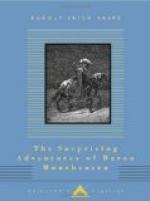expert, and making his way down into Cornwall, he
seems for some years subsequent to 1782 to have been
assay-master and storekeeper of some mines at Dolcoath.
While still at Dolcoath, it is very probable that
he put together the little pamphlet which appeared
in London at the close of 1785, with the title “Baron
Munchausen’s Narrative of his Marvellous Travels
and Campaigns in Russia,” and having given his
jeu d’esprit to the world, and possibly
earned a few guineas by it, it is not likely that
he gave much further thought to the matter. In
the course of 1785 or 1786, he entered upon a task
of much greater magnitude and immediate importance,
namely, a descriptive catalogue of the Collection
of Pastes and Impressions from Ancient and Modern Gems,
formed by James Tassie, the eminent connoisseur.
Tassie engaged Raspe in 1785 to take charge of his
cabinets, and to commence describing their contents:
he can hardly have been ignorant of his employe’s
delinquencies in the past, but he probably estimated
that mere casts of gems would not offer sufficient
temptation to a man of Raspe’s eclectic tastes
to make the experiment a dangerous one. Early
in 1786, Raspe produced a brief but well-executed
conspectus of the arrangement and classification of
the collection, and this was followed in 1791 by “A
Descriptive Catalogue,” in which over fifteen
thousand casts of ancient and modern engraved gems,
cameos, and intaglios from the most renowned cabinets
in Europe were enumerated and described in French and
English. The two quarto volumes are a monument
of patient and highly skilled industry, and they still
fetch high prices. The elaborate introduction
prefixed to the work was dated from Edinburgh, April
16, 1790.
This laborious task completed, Raspe lost no time
in applying himself with renewed energy to mineralogical
work. It was announced in the Scots Magazine
for October 1791 that he had discovered in the extreme
north of Scotland, where he had been invited to search
for minerals, copper, lead, iron, manganese, and other
valuable products of a similar character. From
Sutherland he brought specimens of the finest clay,
and reported a fine vein of heavy spar and “every
symptom of coal.” But in Caithness lay
the loadstone which had brought Raspe to Scotland.
This was no other than Sir John Sinclair of Ulbster,
a benevolent gentleman of an ingenious and inquiring
disposition, who was anxious to exploit the supposed
mineral wealth of his barren Scottish possessions.
With him Raspe took up his abode for a considerable
time at his spray-beaten castle on the Pentland Firth,
and there is a tradition, among members of the family,
of Sir John’s unfailing appreciation of the wide
intelligence and facetious humour of Raspe’s
conversation. Sinclair had some years previously
discovered a small vein of yellow mundick on the moor
of Skinnet, four miles from Thurso. The Cornish
miners he consulted told him that the mundick was
itself of no value, but a good sign of the proximity




